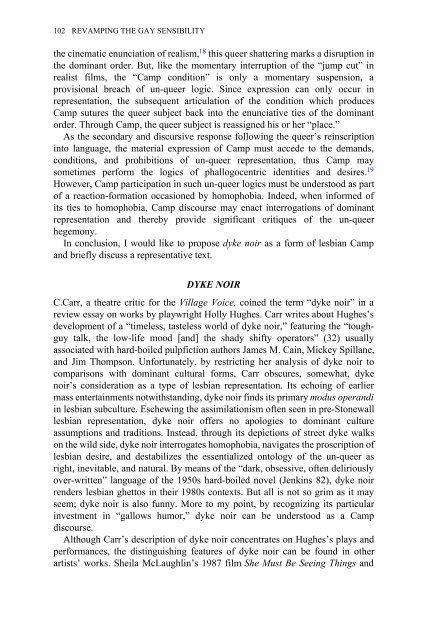Edited by Moe Meyer - Get a Free Blog
Edited by Moe Meyer - Get a Free Blog
Edited by Moe Meyer - Get a Free Blog
Create successful ePaper yourself
Turn your PDF publications into a flip-book with our unique Google optimized e-Paper software.
102 REVAMPING THE GAY SENSIBILITY<br />
the cinematic enunciation of realism, 18 this queer shattering marks a disruption in<br />
the dominant order. But, like the momentary interruption of the “jump cut” in<br />
realist films, the “Camp condition” is only a momentary suspension, a<br />
provisional breach of un-queer logic. Since expression can only occur in<br />
representation, the subsequent articulation of the condition which produces<br />
Camp sutures the queer subject back into the enunciative ties of the dominant<br />
order. Through Camp, the queer subject is reassigned his or her “place.”<br />
As the secondary and discursive response following the queer’s reinscription<br />
into language, the material expression of Camp must accede to the demands,<br />
conditions, and prohibitions of un-queer representation, thus Camp may<br />
sometimes perform the logics of phallogocentric identities and desires. 19<br />
However, Camp participation in such un-queer logics must be understood as part<br />
of a reaction-formation occasioned <strong>by</strong> homophobia. Indeed, when informed of<br />
its ties to homophobia, Camp discourse may enact interrogations of dominant<br />
representation and there<strong>by</strong> provide significant critiques of the un-queer<br />
hegemony.<br />
In conclusion, I would like to propose dyke noir as a form of lesbian Camp<br />
and briefly discuss a representative text.<br />
DYKE NOIR<br />
C.Carr, a theatre critic for the Village Voice, coined the term “dyke noir” in a<br />
review essay on works <strong>by</strong> playwright Holly Hughes. Carr writes about Hughes’s<br />
development of a “timeless, tasteless world of dyke noir,” featuring the “toughguy<br />
talk, the low-life mood [and] the shady shifty operators” (32) usually<br />
associated with hard-boiled pulpfiction authors James M. Cain, Mickey Spillane,<br />
and Jim Thompson. Unfortunately, <strong>by</strong> restricting her analysis of dyke noir to<br />
comparisons with dominant cultural forms, Carr obscures, somewhat, dyke<br />
noir’s consideration as a type of lesbian representation. Its echoing of earlier<br />
mass entertainments notwithstanding, dyke noir finds its primary modus operandi<br />
in lesbian subculture. Eschewing the assimilationism often seen in pre-Stonewall<br />
lesbian representation, dyke noir offers no apologies to dominant culture<br />
assumptions and traditions. Instead, through its depictions of street dyke walks<br />
on the wild side, dyke noir interrogates homophobia, navigates the proscription of<br />
lesbian desire, and destabilizes the essentialized ontology of the un-queer as<br />
right, inevitable, and natural. By means of the “dark, obsessive, often deliriously<br />
over-written” language of the 1950s hard-boiled novel (Jenkins 82), dyke noir<br />
renders lesbian ghettos in their 1980s contexts. But all is not so grim as it may<br />
seem; dyke noir is also funny. More to my point, <strong>by</strong> recognizing its particular<br />
investment in “gallows humor,” dyke noir can be understood as a Camp<br />
discourse.<br />
Although Carr’s description of dyke noir concentrates on Hughes’s plays and<br />
performances, the distinguishing features of dyke noir can be found in other<br />
artists’ works. Sheila McLaughlin’s 1987 film She Must Be Seeing Things and


